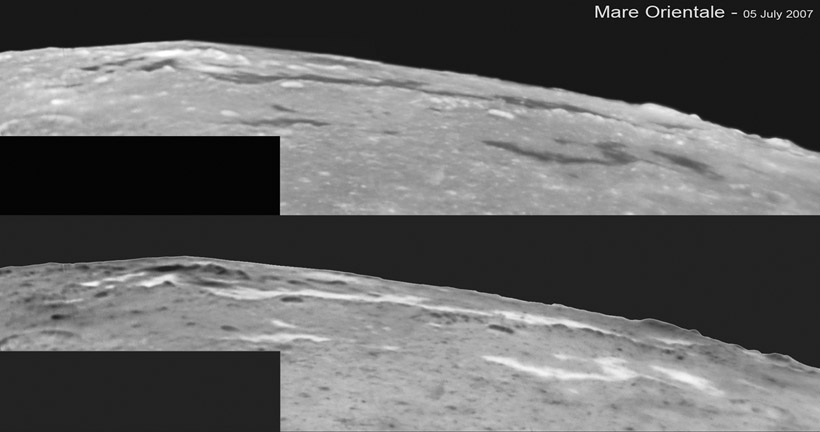|
|
| (7 intermediate revisions by the same user not shown) |
| Line 1: |
Line 1: |
| | __NOTOC__ | | __NOTOC__ |
| | =Floating Lava= | | =Floating Lava= |
| | + | <!-- Start of content --> |
| | + | <div class="post" id="post-1235"> |
| | | | |
| − |
| + | <div class="storycontent"> |
| − | <div class="post" id="post-1235">
| + | <p>[[File:070705_Mare_Orientale_Tar-LPOD.jpg|070705_Mare_Orientale_Tar-LPOD.jpg]]<br /> |
| − |
| |
| − | <div class="storycontent">
| |
| − | <p>[[File:070705_Mare_Orientale_Tar-LPOD.jpg|070705_Mare_Orientale_Tar-LPOD.jpg]]<br />
| |
| | <em>image by [mailto:g.tarsoudis@freemail.gr George Tarsoudis], Alexandroupolis, Greece</em></p> | | <em>image by [mailto:g.tarsoudis@freemail.gr George Tarsoudis], Alexandroupolis, Greece</em></p> |
| − | <p>The ribbons of lava that hug the inner rings of the Imbrium Basin are easy to see when the Sun is high (and librations good). As George’s recent image shows the dark strips of lava contrast well with the general gray ruggedness and the whiteness of mountains that brightly reflect Sunlight. The lower image - which inverts brightness and darkness - makes the lavas appear to float above the surface, almost like they had been poured across the terrain. And of course, that is exactly what happened, except the pouring came out of the ground, up the fractures associated with massive faults that bound each ring. The bright peaks and ridges that appear in the upper image are part of the [http://www.lpod.org/archive/LPOD-2005-02-19.htm Rook Mountains] but none has an individual name. Some are probably the Greek-lettered features labelled by Schröter and Mädler, but exactly which peaks they meant are hard to identify with certainty. But now we can clearly describe Orientale’s landmark peaks, and just as the Apennines have named mountains such as Wolf, Huygens, Bradley and Hadley, these cry out for names. </p> | + | <p>The ribbons of lava that hug the inner rings of the Imbrium Basin are easy to see when the Sun is high (and librations good). As George’s recent image shows the dark strips of lava contrast well with the general gray ruggedness and the whiteness of mountains that brightly reflect Sunlight. The lower image - which inverts brightness and darkness - makes the lavas appear to float above the surface, almost like they had been poured across the terrain. And of course, that is exactly what happened, except the pouring came out of the ground, up the fractures associated with massive faults that bound each ring. The bright peaks and ridges that appear in the upper image are part of the [[February_19,_2005|Rook Mountains]] but none has an individual name. Some are probably the Greek-lettered features labelled by Schröter and Mädler, but exactly which peaks they meant are hard to identify with certainty. But now we can clearly describe Orientale’s landmark peaks, and just as the Apennines have named mountains such as Wolf, Huygens, Bradley and Hadley, these cry out for names. </p> |
| | <p>[mailto:tychocrater@yahoo.com Chuck Wood]</p> | | <p>[mailto:tychocrater@yahoo.com Chuck Wood]</p> |
| | <p><strong>Technical Details:</strong><br /> | | <p><strong>Technical Details:</strong><br /> |
| Line 15: |
Line 14: |
| | Rükl plate 50 and VII<br /> | | Rükl plate 50 and VII<br /> |
| | [http://www.flickr.com/photos/80161946@N00/?saved=1 George’s website]<br /> | | [http://www.flickr.com/photos/80161946@N00/?saved=1 George’s website]<br /> |
| − | [http://the-moon.wikispaces.com/Orientale%2C+Mare Orientale in the-Moon Wiki]</p> | + | [https://the-moon.us/wiki/Orientale%2C_Mare Orientale in the-Moon Wiki]</p> |
| − | <p align="center"> | + | <p><b>Yesterday's LPOD:</b> [[July 7, 2007|Almost Mud]] </p> |
| − | <em>Now you can support LPOD when you buy ANY book from Amazon thru [[LPOD]]</em></p> | + | <p><b>Tomorrow's LPOD:</b> [[July 9, 2007|Straits of Fresnel]] </p> |
| − | <p></p> | + | <!-- Removed reference to store page 2 --> |
| − | </div>
| + | </div> |
| − |
| + | <!-- End of content --> |
| − | | + | {{wiki/ArticleFooter}} |
| − | ---- | |
| − | ===COMMENTS?===
| |
| − | Click on this icon [[image:PostIcon.jpg]] at the upper right to post a comment.
| |




